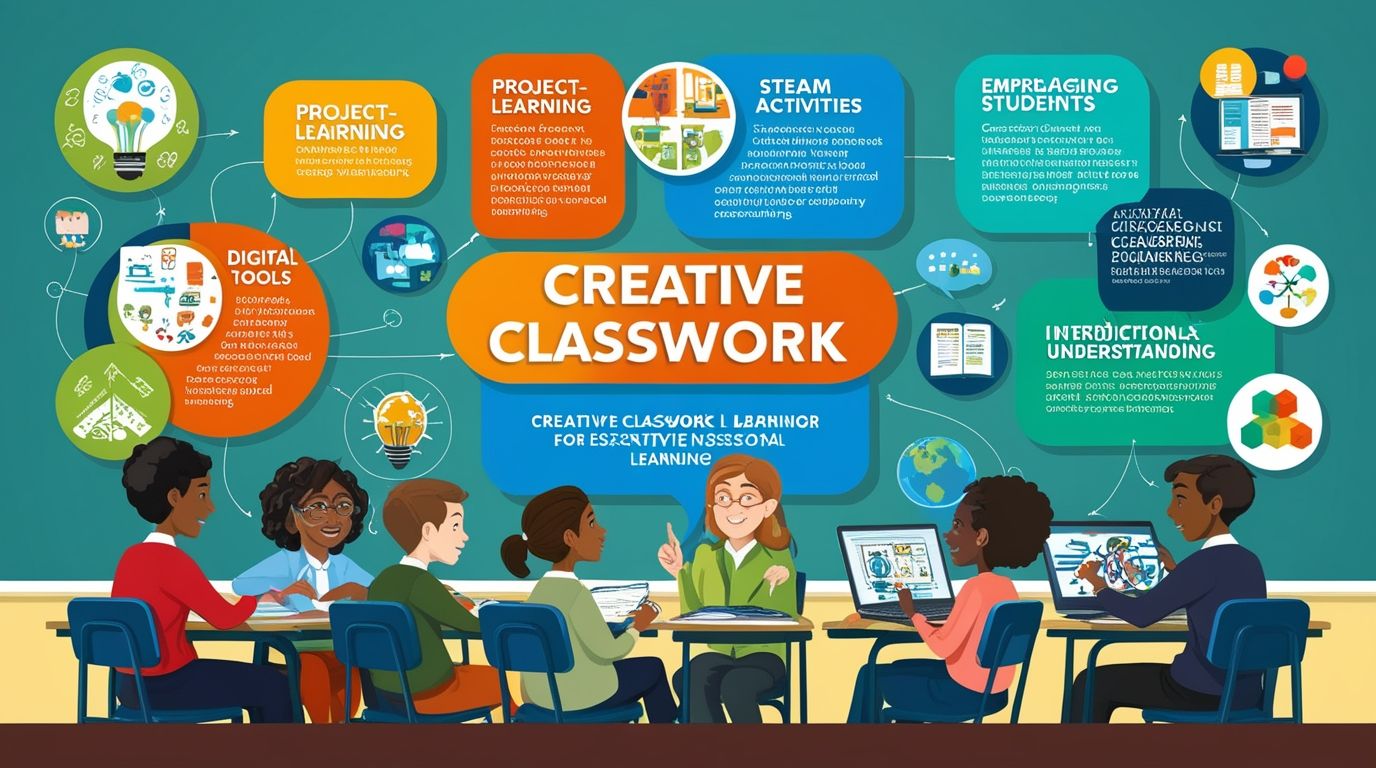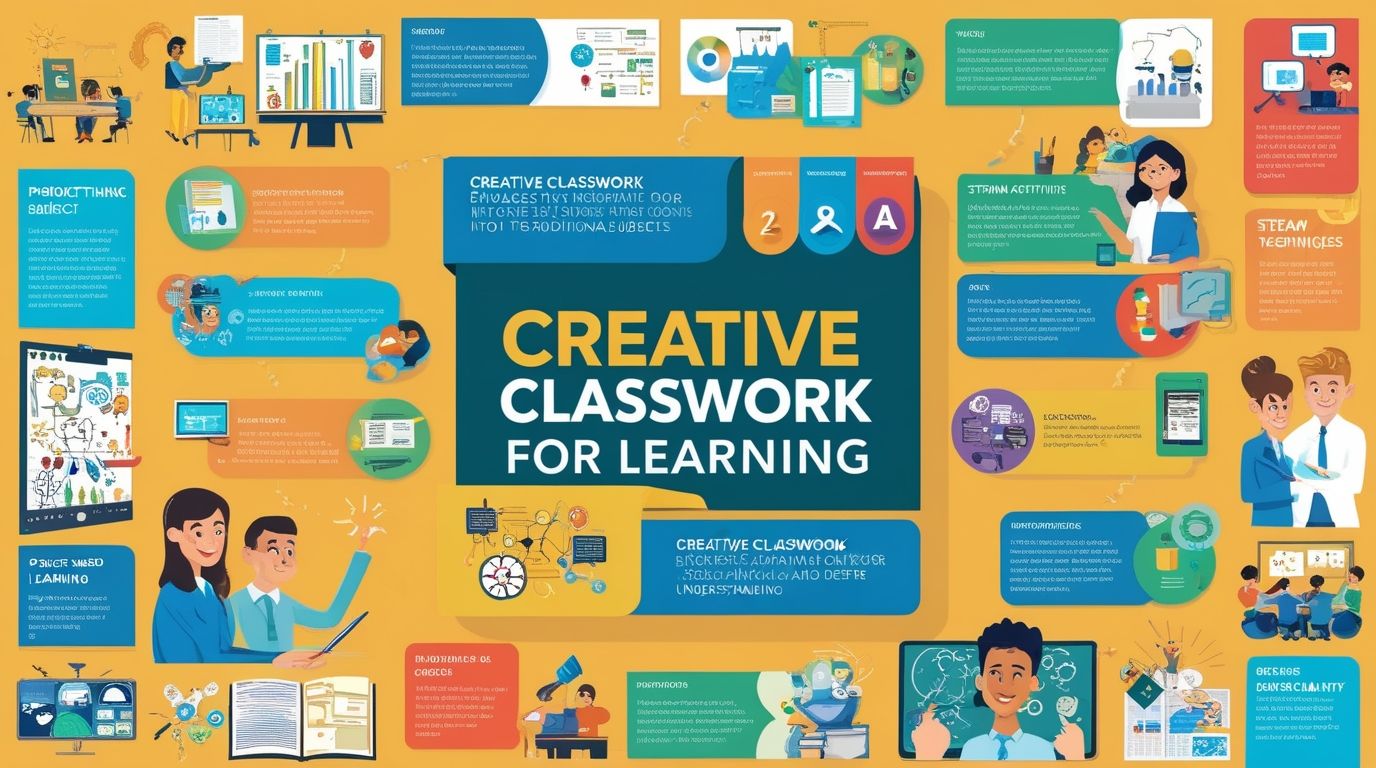Introduction
Creative Classwork for Learning Creative classwork is a powerful tool in the educational landscape, enhancing students’ engagement, critical thinking, and overall learning experience. Traditional teaching methods often focus on rote memorization and standardized testing, but creative classwork encourages students to explore, experiment, and express their understanding in diverse ways. This article explores the benefits of creative classwork, its implementation in the classroom, and best practices for educators, drawing on research and expert insights.
1. The Importance of Creativity in Learning
Creativity in education goes beyond arts and crafts; it encompasses a broad range of activities that foster innovative thinking and problem-solving skills. According to Robinson (2011), creativity is a crucial component of learning because it allows students to make connections between different concepts and ideas. When students engage in creative tasks, they are more likely to retain information and apply it in various contexts. Creative classwork helps students develop critical skills, such as adaptability, resilience, and the ability to think outside the box—skills that are increasingly important in the 21st-century workforce (Robinson, 2011).
2. Benefits of Creative Classwork
Creative classwork has numerous benefits for students, including increased motivation, deeper understanding, and improved academic performance. One of the primary advantages is that it makes learning more enjoyable and engaging. When students are actively involved in creative tasks, they are more likely to participate and take ownership of their learning. A study by Sternberg and Lubart (1995) found that students who engage in creative activities tend to have higher levels of intrinsic motivation, which positively impacts their academic success.
Moreover, creative classwork encourages students to explore multiple solutions to a problem, promoting critical thinking and innovation. By working on projects that require brainstorming, collaboration, and experimentation, students learn to approach challenges from different perspectives. This type of learning environment not only prepares students for academic success but also equips them with the skills needed to navigate real-world problems (Sternberg & Lubart, 1995).
3. Implementing Creative Classwork in the Classroom
To effectively integrate creative classwork into the classroom, educators need to adopt a flexible and student-centered approach. One effective strategy is project-based learning (PBL), where students work on projects that require them to apply their knowledge in practical ways. For example, instead of a traditional lecture on ecosystems, a teacher might have students design their own mini-ecosystems, complete with plants, animals, and environmental factors. This hands-on approach not only makes the lesson more engaging but also helps students understand complex scientific concepts through direct experience (Bell, 2010).
Another method is incorporating arts into various subjects, a practice known as STEAM (Science, Technology, Engineering, Arts, and Mathematics). By integrating arts into STEM subjects, educators can create interdisciplinary lessons that appeal to different learning styles. For instance, a math lesson could involve students creating geometric patterns with art supplies, helping them visualize mathematical concepts in a tangible way (Bequette & Bequette, 2012). This approach not only makes learning more enjoyable but also helps students see the interconnectedness of different disciplines.

4. Best Practices for Creative Classwork
When implementing creative classwork, it is essential for educators to provide clear guidelines and objectives while allowing for flexibility and student choice. One best practice is to create an environment that encourages risk-taking and values the creative process over the final product. According to Amabile (1996), a key factor in fostering creativity is minimizing the fear of failure. Teachers can achieve this by emphasizing effort, experimentation, and improvement rather than just correct answers.
Additionally, it is crucial to incorporate reflection and feedback into creative classwork. After completing a project, students should have the opportunity to reflect on their work, discuss what they learned, and receive constructive feedback from peers and teachers. This process not only helps students internalize the lessons but also encourages them to think critically about their own creative processes and outcomes (Amabile, 1996).
Another effective strategy is to use creative prompts and challenges that stimulate students’ imagination. For example, asking students to create a story that explains a scientific phenomenon or designing a marketing campaign for a historical event can make lessons more dynamic and relevant. These activities encourage students to use their creativity while applying academic concepts in unique ways (Beghetto, 2017).
5. Overcoming Challenges in Creative Classwork
While the benefits of creative classwork are well-documented, there are challenges that educators may face in its implementation. One common obstacle is the perceived lack of time, as creative projects often require more preparation and class time than traditional methods. However, educators can overcome this by integrating creativity into existing lesson plans rather than treating it as an add-on. For instance, a creative writing assignment can be used to assess understanding of a historical event or a scientific concept, thereby serving multiple educational purposes (Beghetto, 2017).
Another challenge is balancing creativity with curriculum standards and assessment requirements. To address this, educators can use rubrics that assess both creative thinking and content mastery, ensuring that students meet learning objectives while engaging in creative work. Furthermore, professional development and collaboration among educators can help teachers share ideas and strategies for incorporating creativity into their classrooms (Bell, 2010).
6. The Role of Technology in Creative Classwork
Technology plays a significant role in facilitating creative classwork. Digital tools, such as multimedia presentations, coding platforms, and online collaboration spaces, provide students with new avenues for creative expression. For example, students can use video editing software to create documentaries on historical events or coding platforms to design interactive games that demonstrate scientific principles. These technologies not only enhance creativity but also prepare students for a tech-savvy world (Resnick, 2007).
Furthermore, technology allows for greater personalization and differentiation in creative classwork. With access to a wide range of digital resources, students can explore topics that interest them and learn at their own pace. This individualized approach helps cater to diverse learning needs and ensures that all students have the opportunity to engage in creative tasks that resonate with them (Resnick, 2007).
7. Conclusion
Creative classwork is a valuable component of modern education, offering numerous benefits that extend beyond the classroom. By fostering a learning environment that values creativity, educators can help students develop critical thinking skills, increase motivation, and prepare for the challenges of the future. Through strategies such as project-based learning, STEAM integration, and the use of technology, teachers can make learning more engaging and meaningful. While challenges exist, they can be overcome with thoughtful planning and a commitment to prioritizing creativity in the classroom. As education continues to evolve, creative classwork will remain a vital tool in cultivating the innovative thinkers of tomorrow.
References:
- Amabile, T. M. (1996). Creativity in Context: Update to the Social Psychology of Creativity. Westview Press.
- Bequette, J. W., & Bequette, M. B. (2012). A Place for Art and Design Education in the STEM Conversation. Art Education, 65(2), 40-47.
- Bell, S. (2010). Project-Based Learning for the 21st Century: Skills for the Future. The Clearing House: A Journal of Educational Strategies, Issues and Ideas, 83(2), 39-43.
- Beghetto, R. A. (2017). Big Wins, Small Steps: How to Lead for and with Creativity. Corwin Press.
- Resnick, M. (2007). Sowing the Seeds for a More Creative Society. Learning & Leading with Technology, 35(4), 18-22.
- Robinson, K. (2011). Out of Our Minds: Learning to be Creative. Capstone Publishing.

4 thoughts on “Creative Classwork for Learning”
Comments are closed.